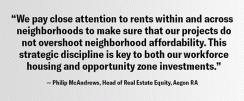Opportunity zones are one of this year’s hottest topics for U.S. investors – particularly those who devote allocations to commercial real estate. Opportunity zones were created in the 2017 Tax Cuts and Jobs Act, wherein state governors were empowered to designate specific census tract areas in their states to receive special tax advantages. Designated areas are focused on economically disadvantaged neighborhoods which have poverty rates of at least 20% and median family incomes no greater than 80% of the surrounding area average. The tax advantage allows investors to defer and reduce capital gains taxes when recent gains are invested in opportunity zones. Moreover, capital gains generated by the investments are eliminated as well if the investments are held for 10 years. In effect, these tax benefits serve as amplifiers of investment returns. State governors have designated a total of 8,700 census tracts as opportunity zones.
Commercial real estate is an excellent vehicle for opportunity zone investment because the need for up-to-date property stock in these disadvantaged neighborhoods is material, and sites for improvements are widely available. Opportunity zone regulations require that “qualifying properties” must involve “substantial improvement” either as ground-up development or sizeable renovation.
Beyond the tax advantages and return potential, many institutions see social benefits that appeal to their stakeholders. In this regard, investors looking for a real estate advisor to guide them through the ins and outs of opportunity zones will find themselves closely aligned with Aegon Real Assets US (Aegon RA), the primary real estate investment center for Aegon Asset Management.
“While a wide variety of investments can be beneficial to areas that are designated as opportunity zones, we believe that it is most advantageous and responsible to focus on multifamily property opportunities in these zones,” says Philip McAndrews, Head of Real Estate Equity at Aegon RA. “More and better housing is needed in economically disadvantaged areas, much more.” McAndrews adds that “our culture at Aegon encourages us to pursue investments which produce compelling returns while also serving the community; we have a strong history of social investing in both the U.S. and Europe. We believe that multifamily investments in opportunity zones do provide social benefit.”

Opportunities and Risks
Aegon RA has a long and deep history of investment in the multifamily sector, both debt and equity. Aegon RA’s applied research staff plays a major role in multifamily strategy especially by analyzing the drivers of investment performance. McAndrews explains that “we’re an institution that builds disciplined strategies around strong top-down applied research combined with strong bottom-up asset management skills. In the current investing environment, we like multifamily and especially workforce multifamily.” This focus informs the firm’s approach to opportunity zones.
The foundation of Aegon RA’s opportunity zone strategy is the array of 30+ metro areas with demographic and economic characteristics that have positive impact on demand for multifamily rentals and constraints on supply. McAndrews says, “Our strategy has two dimensions: on one level we are picking a sector, multifamily, that harmonizes with our expertise and with compelling macroeconomic evidence of strong ongoing market demand. But, on another level, we are parsing the sector to identify the locations that offer statistically demonstrated potential for outstanding rent growth. So, our processes provide support for our commitments to both sector and locations.”
“We’re trying to put and keep the wind in our sails naturally by creating an environment where market selection in and of itself drives rent growth. We believe that enhances the probability that we can achieve underwritten returns,” McAndrews adds.
Aligning Strategy to Current Cyclical and Structural Environment
Aegon RA believes the current state of both the U.S. macroeconomic and real estate cycles support its focus on the multifamily sector as most appropriate for opportunity zone investing. 2019 marks the 10th anniversary of the economic recovery-expansion following the last recession. “It is the longest up-cycle in history. While cycles do not die of old age, vulnerabilities do accumulate. We see vulnerabilities in the increasing tightness of the labor market, which is a drag on economic growth. Employers are reporting increasing difficulty in filling jobs,” McAndrews says. In addition, volatile and uncertain U.S. trade policies have contributed to a slowing in manufacturing and in business investment. Financial markets are taking note and the yield curve is near inversion. U.S. geopolitical stresses add to the uncertainty. For real estate, McAndrews notes that “we see the peaking cycle in the diminishing contribution of capital return to total return, and in hints of more cautious investor appetite as demonstrated in recent weakening property sales.”
In this environment, property investors are advised to examine the relative vulnerability of different property sectors to the maturing cycle. “Monitoring the macroeconomic lay of the land gives us valuable perspective on pricing and return prospects. It is one of our competitive strengths,” says McAndrews. Of the four major sectors, multifamily fares the best in the current environment because of its defensive characteristics, the most important of which is the ongoing strong demand and persistent under-supply of rental housing. While there is some excess supply of high-end rentals in a small number of cities, rental markets are generally very tight. Currently, the national vacancy rate is 6.8% according to the U.S. Census Bureau; historically, rates below 7% have not occurred since the early 1990s.1 McAndrews notes that “in addition to low vacancy rates, lease duration on rentals is very short compared with other sectors, which makes income streams more manageable as leases are constantly turning.”

Multifamily property investments may also be enhanced by a variety of special structural factors that define the current era. Demographically, the huge Millennial cohort has reached prime working age and is bolstering demand for rentals, especially in metro areas with strong employment growth. Millennials are marrying later and having children later, which prolongs their stays in rental housing. Moreover, student debt, slow wage growth, and tight residential mortgage requirements, combined with high prices on single-family homes, are significant barriers to homeownership. “Millennials are largely renters by necessity,” according to McAndrews. “We target our multifamily investing to the metros that they prefer.”
For opportunity zones, the cyclical and structural advantages of multifamily apply, and may even be stronger. On the demand side, opportunity zone neighborhoods can produce multifamily that is more affordable than new construction in prime neighborhoods. “At Aegon RA, we pay close attention to rents within and across neighborhoods to make sure that our projects do not overshoot neighborhood affordability,” McAndrews says. “This strategic discipline is key to both our workforce housing and opportunity zone investments.”
Aegon RA’s experience in multifamily development and construction is well-demonstrated in $4 billion+ in low-income tax credit housing projects since 1987. In addition, the firm has sponsored 58 funds geared to institutional investors that allow them to buy tax credits.2
“We not only have the expertise in the multifamily sector, but we have actually invested in many of the markets that have designated opportunity zones. It’s an extraordinary combination for any sponsor to be able to offer investors,” says McAndrews.
Learn more about opportunity zones investing.
1US Census Bureau, Current Population Survey/Housing Vacancy Survey, July 25, 2019.
2Aegon RA, as of June 30, 2019.
Disclosure
As of October 2019, there is uncertainty regarding future IRS and Treasury Department guidance on Opportunity Zones. Prospective investors should consult with their tax advisor before making any investment into an Opportunity Zone investment vehicle.
Past performance is not indicative of future results. The information contained in this article is for informational purposes only and should not be considered investment advice or a recommendation of any particular security, sector, strategy or investment product. The article contains the current opinions of the firm and is accurate as of the date of the article. Such opinions are subject to change without notice. The firm is under no obligation, expressed or implied, to update the material contained herein.
This article contains forward-looking statements which are based on the firm's beliefs, as well as on a number of assumptions concerning future events, based on information currently available, and are subject to change without notice. These statements involve certain risks, uncertainties and assumptions which are difficult to predict. Consequently, such statements cannot be guarantees of future performance and actual outcomes and returns may differ materially from statements set forth herein. In addition, this material contains information regarding market outlook, rates of return, market indicators and other statistical information that is not intended and should not be considered an indication of the results of any Aegon Real Assets US-managed portfolio.
Aegon Real Assets US, an indirect wholly owned subsidiary of Aegon N.V., is a US-based investment adviser registered with the Securities and Exchange Commission (“SEC”) and part of Aegon Asset Management, the global investment management brand of Aegon Group.






